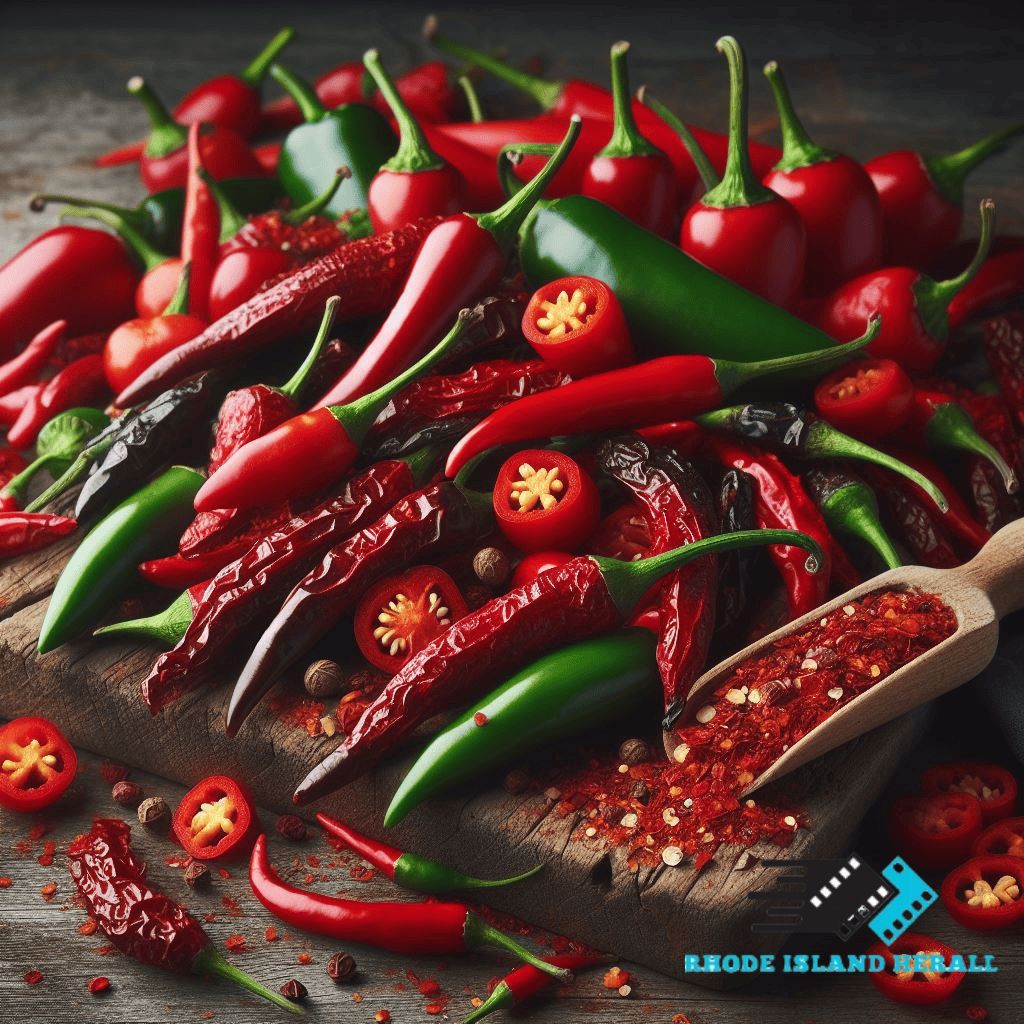The unassuming red chilli, with its vibrant hue and potent kick, has enthralled palates and sparked culinary innovation for millennia. Beyond the fiery sensation that sets taste buds Peppersablaze, this captivating spice holds a wealth of secrets waiting to be unveiled. Delve deeper and discover the captivating world of red chillies – a journey that ignites the senses and nourishes the body.
A Legacy Steeped in History: From Ancient Cultivation to Global Acclaim
Red chillies, also known as cayenne peppers or red peppers, boast a rich history intertwined with human civilization. Archaeological evidence suggests their cultivation stretches back over 7,500 years to Central and South America. Aztec civilizations revered chillies as a sacred food, incorporating them into religious ceremonies and everyday meals. As explorers embarked on daring voyages, chillies embarked on their own global odyssey, captivating taste buds across continents.
Europeans encountered chillies in the 15th century, forever altering their culinary landscape. The fiery spice quickly gained popularity, adding a new dimension of heat to previously bland European cuisine. From fiery Hungarian goulash to the smoky heat of Spanish paprika, chillies became a cornerstone of global gastronomy.
Today, red chillies reign supreme as one of the world’s most beloved spices. Cultivated in virtually every corner of the globe, they add zest to countless cuisines, from the fiery curries of India to the fiery kimchi of Korea. Their versatility extends beyond culinary applications, with uses spanning traditional medicine, natural dyes, and even self-defense sprays.
A Symphony of Spice: Unveiling the Capsaicin Cascade
The fiery essence of red chillies lies within a fascinating molecule called capsaicin. This potent compound binds to specific receptors on the tongue, triggering the burning sensation we associate with chilli heat. Interestingly, capsaicin doesn’t actually burn – it deceives our bodies! The tingling and burning we experience are the body’s response to this unique stimulation.
Capsaicin content varies greatly amongst chilli pepper varieties. The Scoville Heat Unit (SHU) is the scientific measure of a pepper’s heat, with higher SHU values indicating greater capsaicin concentration. Bell peppers, for example, register a measly 0 SHU, while the infamous Carolina Reaper, currently holding the title of the world’s hottest pepper, can scorch taste buds with a staggering 2.2 million SHU.
The red chilli’s heat profile goes beyond a simple burn. It often presents a complex interplay of flavours, ranging from sweet and fruity to earthy and smoky. This symphony of taste adds depth and intrigue to countless culinary creations.
A Nutritional Powerhouse: Unveiling the Health Benefits of Red Chilli
Beyond the fiery facade, red chillies offer a surprising array of health benefits. They are a concentrated source of vitamins and minerals, including Vitamin A, Vitamin C, Vitamin E, Vitamin B6, Potassium, and Manganese.
-
Vitamin A: Essential for maintaining healthy vision and immune function, red chillies are a rich source of Vitamin A in the form of beta-carotene.
-
Vitamin C: A powerful antioxidant, Vitamin C bolsters the immune system and promotes collagen production for healthy skin and joints.
-
Vitamin E: Another potent antioxidant, Vitamin E safeguards cells from damage and may contribute to cognitive health.
-
Vitamin B6: Crucial for energy metabolism and nervous system function, Vitamin B6 plays a vital role in overall health.
-
Potassium: This essential mineral regulates blood pressure and supports healthy muscle function.
-
Manganese: An essential trace mineral, manganese aids in bone health, carbohydrate metabolism, and antioxidant function.
The capsaicin within red chillies also holds significant health benefits. Studies suggest capsaicin may:
-
Aid in Weight Management: Capsaicin may boost metabolism and promote feelings of satiety, potentially aiding in weight management efforts.
-
Reduce Pain: Capsaicin possesses analgesic properties, offering potential relief from pain associated with arthritis, headaches, and migraines.
-
Improve Circulation: Capsaicin may improve blood flow and reduce the risk of blood clots.
-
Combat Inflammation: Capsaicin exhibits anti-inflammatory properties, potentially aiding in conditions like psoriasis and rheumatoid arthritis.
-
Fungal and Bacterial Properties: Preliminary research suggests capsaicin may possess antifungal and antibacterial properties.
It’s important to note that while red chillies offer a bounty of health benefits, moderation is key. Excessive consumption can irritate the digestive system and cause discomfort.
Selecting the Perfect Pepper: A Guide for Chilli Enthusiasts
With countless chilli varieties available, selecting the right one can be daunting. Here’s a guide to navigate the fiery world of chillies:
- Heat Levels: Scoville Heat Units (SHU) measure a chilli’s spiciness. Bell peppers have 0 SHU, while the fiery Carolina Reaper can reach over 2 million SHU. Choose your chilli based on your desired heat level.
- Freshness Matters: Opt for firm, brightly colored chillies with unblemished skin for the best flavor and heat.
- Storage Tips: Store fresh chillies in the crisper drawer of your refrigerator for up to a week. Dried chillies can be stored in a cool, dark pantry for several months.
Culinary Inspiration: Unleashing the Red Chilli’s Potential
The red chilli is a culinary chameleon, effortlessly adapting to various dishes. Here are some inspirational ideas to unleash its fiery potential:
- Spice Up Your Sauces: Elevate your homemade tomato sauce, marinades, or vinaigrettes with a touch of chopped red chilli or a sprinkle of chilli flakes.
- Fiery Stir-fries: Incorporate sliced red chillies into your next stir-fry for a burst of heat and smoky flavour.
- Spicy Dips: Whip up a fiery salsa or sambal oelek using red chillies as the base ingredient.
- Curried Delights: Red chillies are a key ingredient in countless curries, adding depth and heat to these flavorful dishes.
Beyond the Heat: Exploring Flavor Profiles
Red chillies aren’t just about the heat. Different varieties boast unique flavour profiles that elevate culinary creations. Here are some popular examples:
-
Jalapeño: This versatile pepper offers mild to medium heat with a fresh, grassy flavour. Perfect for salsas, guacamole, and pickling.
-
Serrano: Similar in heat level to jalapeños, serranos possess a brighter, more citrusy flavour. Ideal for adding zest to stir-fries and ceviches.
-
Poblano: This large, wide pepper offers mild heat and a rich, earthy flavour profile. Popular for stuffing and roasting.
-
Guajillo: This dried chilli boasts a deep, smoky flavour with hints of berry and chocolate. A mainstay in Mexican moles and adobos.
-
Chipotle: Smoke-dried jalapeños and chipotles offer a complex flavour profile – smoky, earthy, with a lingering heat. Perfect for adding depth to chili and barbecue dishes.
By understanding the heat levels and unique flavour profiles of different red chillies, culinary enthusiasts can create dishes that tantalize the taste buds and ignite the senses.
From Seed to Spice: Cultivating Your Own Red Chilli Bounty
For the adventurous home gardener, cultivating your red chillies offers a rewarding and flavorful experience. Here’s a basic guide to get you started:
-
Choosing Your Chilli: Select chilli varieties suited to your climate and desired heat level. Popular beginner options include jalapeños and cayenne peppers.
-
Planting and Care: Sow chilli seeds indoors well before the last frost. Provide plenty of sunlight, well-drained soil, and consistent watering.
-
Harvesting: Once chillies reach their desired size and colour, harvest them using sharp pruners or scissors. Wear gloves when handling chillies to avoid skin irritation.
Drying and Storing:
-
Drying: For long-term storage, dry your chillies by placing them on a screen in a warm, well-ventilated area. Once completely dry, store them in airtight containers in a cool, dark place.
-
Freezing: For a quicker method, freeze fresh chillies whole or sliced. Frozen chillies retain their flavor and heat well.
With a little planning and care, you can cultivate and enjoy the homegrown bounty of red chillies, adding a touch of fiery flair to your culinary creations.
Beyond the Kitchen: Unveiling the Unexpected Uses of Red Chilli
Red chillies transcend the realm of culinary delights. Their unique properties lend themselves to a surprising array of applications:
-
Natural Dyes: The vibrant pigments in red chillies can be used to create natural dyes for fabrics and textiles.
-
Pest Repellent: The capsaicin in chillies acts as a natural insect repellent, deterring unwanted pests in gardens and homes.
-
Self-Defence Sprays: The intense irritation caused by capsaicin makes red chillies a common ingredient in self-defence sprays.
-
Traditional Medicine: In various cultures, red chillies are used in traditional medicine to alleviate pain, improve circulation, and treat a variety of ailments.
A Final Note: A Fiery Beacon Awaits
The red chilli, a fiery beacon of flavour and function, offers a captivating journey for the curious explorer. Delve deeper into this world, experiment with different varieties, and unlock the potential to transform your culinary creations. Unleash a fiery symphony of taste sensations, from the delicate kiss of sweetness in a Poblano to the scorching intensity of a Carolina Reaper. Embrace the health benefits this fiery fruit imparts, and embark on a culinary adventure that will tantalize your taste buds and invigorate your well-being.
Click Now
Red Chilli FAQs
Are red chillies healthy?
Yes! Red chillies are a rich source of vitamins, minerals, and capsaicin, which offers potential health benefits like weight management, pain relief, and improved circulation.
How hot are red chillies?
Heat varies greatly. Jalapeños are mild, while Carolina Reapers are scorching. Scoville Heat Units (SHU) measure heat – higher SHU means hotter.
What are the different types of red chillies?
There are hundreds! Popular varieties include jalapeños (mild, grassy), serranos (bright, citrusy), poblanos (mild, earthy), guajillo (smoky, berry), and chipotle (smoky, earthy, lingering heat).
How can I use red chillies in cooking?
Fresh, dried, ground, or infused in oil – the options are endless! Enjoy them raw, add them to salsas, use dried chillies in soups, or infuse oil for a subtle heat.
How can I grow red chillies at home?
Start by choosing a variety suited to your climate. Sow seeds indoors, provide warmth, sunlight, and good drainage. Harvest when they reach desired size and color.
Can I freeze red chillies?
Absolutely! Freeze them whole or sliced for a quick and convenient way to preserve their flavor and heat.
How do I handle red chillies without burning myself?
Wear gloves! Capsaicin can irritate skin. Wash hands thoroughly after handling.
What if I accidentally eat a really hot chilli?
Drink milk! It helps neutralize capsaicin. Water won’t work.
Do red chillies have any uses besides cooking?
Yes! They can be used as natural dyes, pest repellents, self-defense sprays, and even in traditional medicine.
What’s the difference between red chillies and chili peppers?
There isn’t much! “Red chilli” and “chili pepper” are often used interchangeably.
Can red chillies help me lose weight?
Capsaicin may boost metabolism and promote satiety, potentially aiding weight management efforts, but a balanced diet and exercise are key.
Are red chillies bad for my stomach?
In moderation, they’re generally fine. Excessive consumption can irritate the digestive system.
Where can I learn more about different chilli varieties?
Look for resources from reputable gardening websites or seed companies. They often provide detailed information about chilli pepper varieties.




